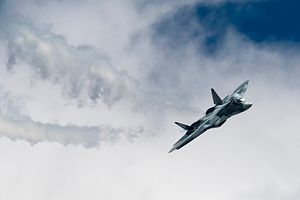Russia’s military aircraft industry has once more offered the Indian Air Force (IAF) to co-develop a variant of the Sukhoi Su-57 fighter aircraft, Russia’s first purported indigenously designed and built fifth-generation stealth fighter jet. “I believe that we should resume this project, Russia is open to that,” Deputy Director of Russia’s Federal Service for Military and Technical Cooperation, Vladimir Drozhzhov, said on July 9. “We are ready and are proposing this program to our Indian partners.”
India withdrew in 2018 from the co-development and production of the Su-57, known in India as the Perspective Multi-role Fighter (PMF). The decade-long joint project was spearheaded by India’s state-run Hindustan Aeronautics Limited (HAL) and Russia’s Sukhoi and aimed to design and produce an improved variant of the Su-57. Reasons for India pulling out of the project included Russia’s refusal to share the source code of the jet’s flight computer and mission software. Without the source codes, the IAF would not have been capable of upgrading the fighter jet without Russian support in the future.
The IAF has also repeatedly criticized the aircraft’s in-flight performance — especially the fighter jet’s engine. The IAF was also concerned over the aircraft’s inability to meet low-observability requirements laid out by the service at the beginning of the joint defense project, which suffered from multiple delays, as I noted elsewhere:
Delays were caused by New Delhi and Moscow disagreeing over many fundamental aspects of the joint development project including work and cost share, aircraft technology, as well as the number of aircraft to be ordered. After evaluating the first PAK FA T-50 [Su-57] prototype (the Russian prototype of the PMF), the [ IAF] wanted more than 40 changes addressing, among other things, perceived weaknesses in the plane’s engine, stealth, and weapon-carrying capabilities.
Both sides also failed to come to terms on the number of aircraft to be produced:
Russia announced in late 2015 that it would only induct a squadron (18-24 aircraft) of PAK FA fighter aircraft, and procure additional Sukhoi Su-35 aircraft instead. The original deal involved Russia procuring 250 and India 144 aircraft at a cost of around $30 billion by 2022. As a result, India threatened to abandon the project in its entirety. Russia in turn made a number of concessions including an offer to cut down its financial contribution from $6 to $ 3.7 billion for three PAK FA T-50 prototypes and substantial technology transfers.
Even if the Russian defense industry were to begin granting the IAF full access to the software codes, it is unlikely that Russia would be able to address the purported multiple shortcomings of the Su-57 to the satisfaction of the Indian military within a reasonable time frame.
Russia has also offered India an export variant of the Su-57, designated Su-57E. However, Russian President Vladimir Putin has to date not approved the Su-57E for foreign sales.
Notably, the Russian Ministry of Defense announced in 2018 that it will not mass-produce the Su-57. However, this May Putin announced that the Russian Air Force will induct 76 Su-57s by 2028. Originally, the Kremlin had committed to buying only 16 of the jets by 2027.
The Russian military aircraft industry announced in June that it is ready to start mass-producing the aircraft. Russian Minister of Defense, Sergei Shoigu, also revealed this year that the per-unit cost per Su-57 and associated equipment went down by 20 percent. He did not elaborate why the aircraft suddenly became cheaper.
The Russian Air Force is expected to take delivery of two new Su-57s prototypes by the end of 2019 and two more aircraft in 2020. A total of 10 Su-57 prototypes are currently undergoing testing and evaluation with the service.
































